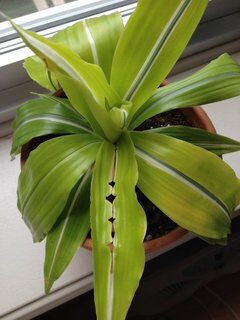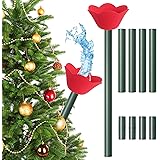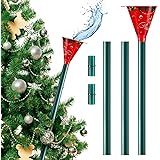Have you noticed small holes in your dracaena leaves? Don’t worry, we’ve got you covered. These tiny openings might seem insignificant, but they can actually be a sign of something going on with your plant.
In this article, we’ll delve into the reasons behind these holes and provide you with practical solutions to help your dracaena thrive. So, if you’re curious about what could be causing those holes in dracaena leaves and how to address the issue, keep reading!
Holes in Dracaena Leaves: Causes, Prevention, and Treatment
Dracaena is a popular houseplant known for its attractive foliage and ability to thrive in indoor environments. However, one common issue that can affect the health and appearance of dracaena plants is the presence of holes in their leaves.
These holes can be alarming to plant owners, but understanding the causes behind them is crucial in order to effectively prevent and treat the problem. In this article, we will delve into the various causes of holes in dracaena leaves, explore preventive measures, and discuss potential treatments.
Read More: About Does Monstera Like Coffee Grounds?
Common Causes of Holes in Dracaena Leaves
There are several potential factors that can lead to the development of holes in dracaena leaves. Let’s take a closer look at some of the most common causes:
- Insect Infestation:
Insects such as spider mites, thrips, or mealybugs can attack dracaena plants, causing damage to the foliage. These pests often chew on the leaves, resulting in the formation of holes. Regularly inspecting the leaves for the presence of insects and taking immediate action to eradicate them can help prevent further damage.
- Physical Damage:
Dracaena leaves are delicate and can be easily damaged by accidental impacts or rough handling. This can lead to the formation of holes or tears in the leaves. Avoid placing the plant in areas where it is likely to be bumped or brushed against, and handle the plant with care during transplanting or maintenance.
- Fungal or Bacterial Infections:
Some fungal or bacterial infections can cause rotting or decay of dracaena leaves, resulting in the formation of holes. Overwatering or poor drainage can create a favorable environment for these pathogens to thrive.
Proper watering practices, adequate air circulation, and ensuring well-draining soil can help prevent such infections.
- Nutrient Deficiencies:
Inadequate levels of essential nutrients, particularly calcium and magnesium, can lead to the development of holes in dracaena leaves. A balanced fertilizer regimen and regular soil testing can help identify and address any nutrient deficiencies in the plant.
- Environmental Factors:
Extreme temperature fluctuations, direct exposure to sunlight, or low humidity levels can stress dracaena plants, making them more susceptible to developing holes in the leaves.
Maintaining consistent temperature and humidity levels, providing appropriate shade, and avoiding sudden changes in environmental conditions can minimize this risk.
Preventing Holes in Dracaena Leaves
Prevention is key when it comes to maintaining the health and appearance of dracaena plants. Here are some effective methods to prevent the formation of holes in their leaves:
- Inspect Regularly:
Regularly inspect the plant’s leaves, both top and bottom surfaces, for any signs of pests or damage. Early detection can help prevent the problem from worsening and spreading to other leaves.
- Practice Good Hygiene:
Maintain cleanliness around the plant and remove any fallen debris or dead leaves promptly. This helps eliminate potential hiding places for pests and reduces the risk of fungal or bacterial infections.
- Avoid Overwatering:
Overwatering can lead to root rot and create a conducive environment for pathogens. Allow the topsoil to dry out between waterings and ensure proper drainage to prevent waterlogging.
- Provide Adequate Lighting:
Dracaena plants thrive in bright, indirect light. Avoid placing them in direct sunlight, as this can scorch the leaves and increase the risk of damage or stress.
- Monitor Humidity:
Dracaena plants prefer moderate humidity levels. If the air is too dry, use a humidifier or place the plant on a tray filled with water and pebbles to increase moisture around the plant.
- Maintain Ideal Temperature:
Maintain a temperature range of 65-80°F (18-27°C) for optimal growth. Avoid exposing the plant to extreme temperature fluctuations, such as cold drafts or hot air vents.
- Fertilize Regularly:
Use a balanced fertilizer specifically formulated for indoor plants and follow the recommended schedule. Regular fertilization ensures that the plant receives the necessary nutrients to maintain healthy foliage.
Treating Holes in Dracaena Leaves
If your dracaena plant already has holes in its leaves, don’t worry! There are steps you can take to address the issue:
- Remove Affected Leaves:
Carefully remove leaves that have extensive damage or are heavily infested with insects. This helps prevent the spread of pests or diseases to healthy leaves.
- Control Insect Infestations:
Identify the specific insect plaguing your dracaena plant and use appropriate methods to control them. This may include using insecticidal soap, neem oil, or introducing natural predators like ladybugs. Follow the instructions carefully and repeat treatments as necessary.
- Address Fungal or Bacterial Infections:
If the holes are caused by a fungal or bacterial infection, use a suitable fungicide or bactericide as recommended by a plant care professional. Adjust watering practices to prevent overwatering and improve drainage conditions.
- Reassess Environmental Conditions:
Ensure that the plant is not exposed to extreme temperatures or low humidity levels. Make necessary adjustments to create a more favorable growing environment.
- Boost Nutrient Levels:
If nutrient deficiencies are suspected, consider fertilizing the plant with a balanced fertilizer that contains adequate levels of calcium and magnesium. Consult with a plant expert to determine the appropriate dosage and timing.
Remember, patience is key when treating holes in dracaena leaves. It may take some time for the plant to recover and for new, healthy leaves to grow. In the meantime, continue to provide optimal care to promote overall plant health.
To summarize, holes in dracaena leaves can be caused by insect infestations, physical damage, fungal or bacterial infections, nutrient deficiencies, or unfavorable environmental conditions.
By practicing preventive measures and promptly addressing the underlying causes, you can help ensure the well-being and visual appeal of your dracaena plants.
Read More: About Why Are My Aquarium Plants Melting?
Frequently Asked Questions (FAQs)
Holes in dracaena leaves can be caused by various factors such as pest infestation, fungal or bacterial infections, physical damage, or nutrient deficiencies.
Common pests that can cause holes in dracaena leaves include spider mites, thrips, mealybugs, and caterpillars. Regularly inspect your plant for signs of these pests and take appropriate measures to control them.
Look closely at the leaves for visible signs of pests such as tiny webs, eggs, larvae, or adult insects. You may also notice yellowing or wilting of the leaves, sticky residue, or distorted growth. Consult a pest identification guide or seek professional advice if unsure.
To prevent pest infestation, regularly inspect your dracaena for any signs of pests. Keep the plant clean by wiping the leaves with a damp cloth. Avoid overwatering, as moist conditions can attract pests. If necessary, use organic or chemical insecticides as directed.
Yes, fungal or bacterial infections can cause holes in dracaena leaves. Common fungal infections such as leaf spot or leaf blight can lead to the formation of holes. Proper sanitation, adequate air circulation, and avoiding overwatering can help prevent these infections.
Signs of fungal or bacterial infections in dracaena leaves include the appearance of dark or necrotic spots, lesions, or irregularly shaped holes. The affected areas may also show signs of discoloration or decay. Promptly remove infected leaves and adjust care practices to prevent further spread.
Yes, physical damage such as accidental tearing, grazing by animals, or rough handling can lead to holes in dracaena leaves. Take precautionary measures to protect your plant from potential sources of damage and handle it with care.
Nutrient deficiencies, particularly calcium or magnesium deficiencies, can weaken the structure of dracaena leaves, making them more susceptible to developing holes. Ensure your plant receives a balanced fertilizer and proper care to maintain optimal nutrient levels.
Final Thoughts
Dracaena leaves with holes can indicate various causes, ranging from insect pests to fungal diseases. To identify the specific issue, closely examine the affected leaves and look for signs of insects like spider mites or caterpillars. If pests are present, treat the plant with natural or chemical insecticides. On the other hand, if the holes have a stippled appearance, it could be a result of a fungal disease.
In this case, prune the affected foliage and ensure proper air circulation and watering practices to prevent the disease’s spread. Regular inspections and prompt action will help maintain the health of your dracaena plant and prevent further damage from the holes in its leaves.
Auto Amazon Links: No products found.
Perfect Plants Christmas Tree Saver 8oz. | Easy Use Xmas Tree Preserver Food | Have Healthy Green Christmas Trees All Holiday Season
$9.97 (as of December 16, 2025 05:22 GMT +00:00 - More info- Product prices and availability are accurate as of the date/time indicated and are subject to change. Any price and availability information displayed on [relevant Amazon Site(s), as applicable] at the time of purchase will apply to the purchase of this product.
FirEver Pure Christmas Tree Food | Preserver Additive & Season Extender for Live Xmas Trees | Keep It Green, Reduce Needle-Drop | Miracle Freshness (8 oz)
$14.99 (as of December 16, 2025 05:22 GMT +00:00 - More info- Product prices and availability are accurate as of the date/time indicated and are subject to change. Any price and availability information displayed on [relevant Amazon Site(s), as applicable] at the time of purchase will apply to the purchase of this product.
Rocky Mountain Goods Christmas Tree Food - 8 oz Tree Preservative - Reduce Needle Drop - Greener Scent - Fir, Pine, Spruce Trees - Extend Tree Life
$9.95 (as of December 16, 2025 05:22 GMT +00:00 - More info- Product prices and availability are accurate as of the date/time indicated and are subject to change. Any price and availability information displayed on [relevant Amazon Site(s), as applicable] at the time of purchase will apply to the purchase of this product.
EZMeetU Christmas Tree Watering Funnel, 47 Inch Flower Shape Adjustable 6 Section Design, Christmas Tree Watering System, Christmas Tree Waterer, Long Funnel Wide Opening Reusable, Plant Watering Tool
$16.99 (as of December 16, 2025 05:22 GMT +00:00 - More info- Product prices and availability are accurate as of the date/time indicated and are subject to change. Any price and availability information displayed on [relevant Amazon Site(s), as applicable] at the time of purchase will apply to the purchase of this product.
VICAMB 39.3 Inch Christmas Tree Watering Funnel,Christmas Tree Watering System Device,Long Tree Watering Funnel Spout for Indoor Outdoor Xmas Tree
$17.99 (as of December 16, 2025 05:22 GMT +00:00 - More info- Product prices and availability are accurate as of the date/time indicated and are subject to change. Any price and availability information displayed on [relevant Amazon Site(s), as applicable] at the time of purchase will apply to the purchase of this product.
Snow Joe Premium Enviro Blend Ice Melt, Green-Coated Deicer Crystals, 50 lb - Safer Melter for Vegetation, Concrete & Metals w/ Anti-Corrosion Calcium Magnesium Acetate
$32.97 (as of December 12, 2025 19:27 GMT +00:00 - More info- Product prices and availability are accurate as of the date/time indicated and are subject to change. Any price and availability information displayed on [relevant Amazon Site(s), as applicable] at the time of purchase will apply to the purchase of this product.
Muddy Mat® Shown on TV Super Absorbent Microfiber Dog Door Mat for Muddy Paws, Non-Slip Washable Pet Rug, Quick Dry Chenille Entryway Carpet, Machine Washable Indoor Outdoor mat, Grey 30"x19"
$24.95 (as of December 12, 2025 19:27 GMT +00:00 - More info- Product prices and availability are accurate as of the date/time indicated and are subject to change. Any price and availability information displayed on [relevant Amazon Site(s), as applicable] at the time of purchase will apply to the purchase of this product.
ivtivfu Rolling Grill Basket, Removable Wooden Handle, 304 Stainless Steel, Nesting BBQ Tools, Smoker Grilling Accessories for Vegetable, Outdoor Cooking Camping, Birthday Gifts for Men Dad Husband
$25.99 (as of December 12, 2025 19:27 GMT +00:00 - More info- Product prices and availability are accurate as of the date/time indicated and are subject to change. Any price and availability information displayed on [relevant Amazon Site(s), as applicable] at the time of purchase will apply to the purchase of this product.
XXXFLOWER Plant Terrarium with Wooden Stand, Air Planter Bulb Glass Vase Metal Swivel Holder Retro Tabletop for Hydroponics Home Garden Office Decoration - 3 Bulb Vase
$18.98 (as of December 12, 2025 19:27 GMT +00:00 - More info- Product prices and availability are accurate as of the date/time indicated and are subject to change. Any price and availability information displayed on [relevant Amazon Site(s), as applicable] at the time of purchase will apply to the purchase of this product.
Zevo Flying Insect Trap Official Refill Cartridges - Fits Both Zevo Trap & MAX Indoor Fly Trap - Authentic Trap+Lock Technology to Catch Gnats, House & Fruit Flys (4 Official Refill Cartridges)
$14.97 (as of December 12, 2025 19:27 GMT +00:00 - More info- Product prices and availability are accurate as of the date/time indicated and are subject to change. Any price and availability information displayed on [relevant Amazon Site(s), as applicable] at the time of purchase will apply to the purchase of this product.











